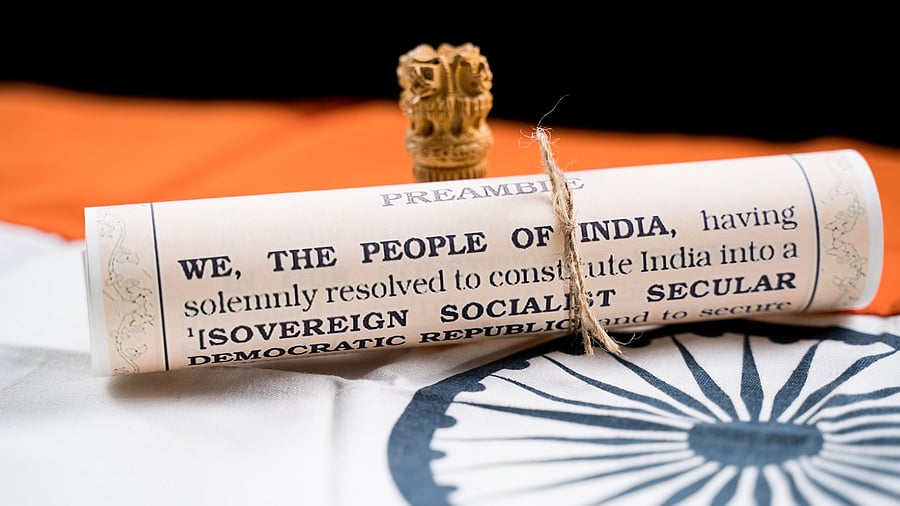
The Preamble of india. Image for representation.
Credit: iStock Photo
Rashtriya Swayamsevak Sangh General Secretary Dattatreya Hosabale recently reignited a decades-old debate: should the words “socialist” and “secular” remain in the Preamble to the Constitution? Claiming these terms were inserted during the Emergency via the 42nd Amendment without sufficient deliberation, he argues they deviate from the original vision of the framers. Vice President Jagdeep Dhankhar has echoed this view, calling their inclusion a “travesty of justice” and “sacrilege to the spirit of Sanatana.” But this renewed debate is less about constitutional fidelity and more about politics—sharp, strategic, and ideological.
The Constituent Assembly, between 1946 and 1949, considered including “socialist,” “secular,” and even “God” in the Preamble but ultimately refrained. While many members, including Jawaharlal Nehru, leaned toward socialism, they resisted enshrining any rigid economic ideology. B R Ambedkar ensured a democratic framework without tying India to one economic model. Amendments by H V Kamath and others to include “socialist” were debated but found insufficient support. Similarly, while secularism was practiced and supported, the framers opined it was enshrined in the broader constitutional values of liberty, equality, justice, and fraternity.
Thus, when the Constitution came into force in 1950, it deliberately did not include the words “socialist” or “secular.” This was not an oversight but a conscious choice. Ambedkar and Nehru believed that India’s diversity was better served by principles that carried the essence of those ideas without codifying them in narrow terms. The spirit of secularism and social justice was already interwoven through the Fundamental Rights and Directive Principles.
However, in 1976, during the Emergency, the Indira Gandhi government inserted “socialist” and “secular” into the Preamble through the 42nd Amendment. This action has been debated since—not so much for the ideals themselves, but for the context in which it was done. Critics argue it was a political manoeuvre under an authoritarian regime, lacking broad consultation. But legally and philosophically, the principles of socialism and secularism were already part of India’s constitutional fabric.
So why revisit the issue now? Hosabale’s statement—and Dhankhar’s reinforcement—arrives in a politically charged atmosphere where identity politics dominates discourse. It raises the suspicion that the current government may be testing the waters. Is this really about constitutional purification or ideological realignment?
Reopening the question of these terms serves two clear political objectives: (i) It helps ideological forces like the RSS distance the Indian Constitution from the Nehruvian legacy, aiming to recast the Republic in the image of cultural nationalism. (ii) It creates rhetorical ammunition against opposition parties that defend these words as emblems of inclusive governance and economic justice.
Supporters of the removal claim that the terms are outdated or misused. But in the Indian context, “secularism” means equal respect for all religions and a non-partisan State, while “socialism” implies commitment to equitable distribution and welfare, not Marxist dogma.
The judiciary has affirmed these principles repeatedly. In S R Bommai (1994), the Supreme Court categorically held secularism as a basic feature of the Constitution, immune from amendment—a position anchored in the landmark Kesavananda Bharati judgement. Similarly, welfare and distributive justice have been consistently upheld through judicial interpretation of the Directive Principles.
Should the State reflect a shared citizenship across all identities or lean toward a dominant cultural ethos? Should economic justice be a constitutional commitment or left to the invisible hand of the market? These are not technicalities—they are fundamental questions of constitutional morality and public purpose.
We must also remember the context in which the framers worked. India was emerging from colonialism, partitioned on religious lines, impoverished, and largely illiterate. They knew secularism was vital to ensure religious harmony in a deeply diverse society. They also understood that socialism—though not in the Marxist sense—was necessary to uplift millions living in deprivation. Economic reforms in 1991 may have liberalised the market, but India never abandoned its social welfare commitments. Even the USA and UK incorporate socialist features in areas like health care and social security.
Ultimately, the Constitution is a political document—not in a partisan sense, but as an embodiment of political consensus and national vision. The fact that “socialist” and “secular” were omitted in 1950 does not mean India wasn’t those things. Nor does their insertion in 1976 prove that India became socialist or secular only thereafter. They merely reflected what was always embedded in our democratic journey.
The present debate is not about semantics or rectification. It is about power, identity, and the ideological direction of the nation. We, the People, must see the rhetoric and recognise the politics behind the posturing. “Socialist” and “secular” are more than words—they are aspirations. And challenging them in the name of constitutional purity is, in truth, a battle over India’s soul.
Indeed, my friends, It’s Politics, Stupid!
(The writer is a practicing advocate in the Madras High Court and author of
Constitution and Its Making/Working)